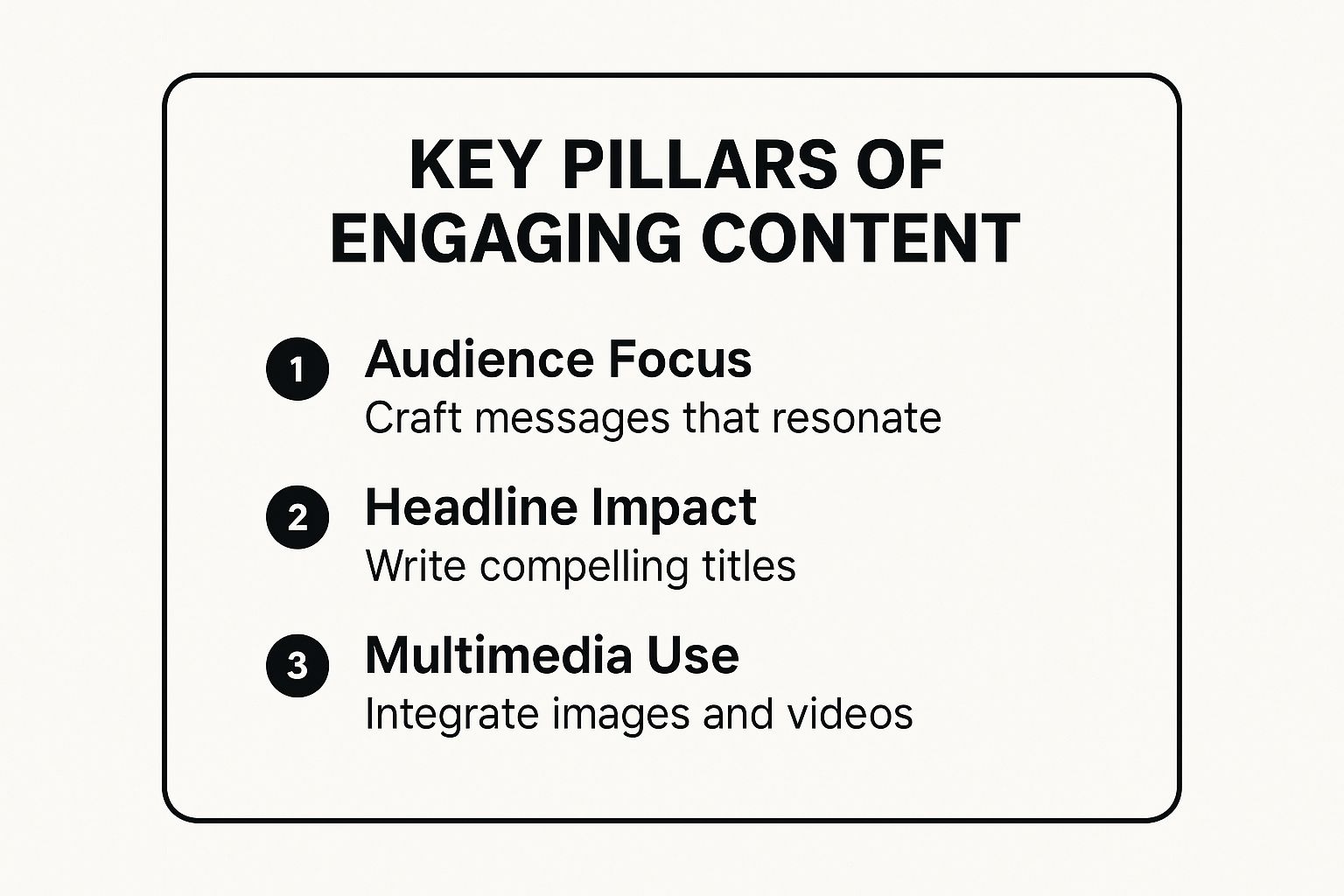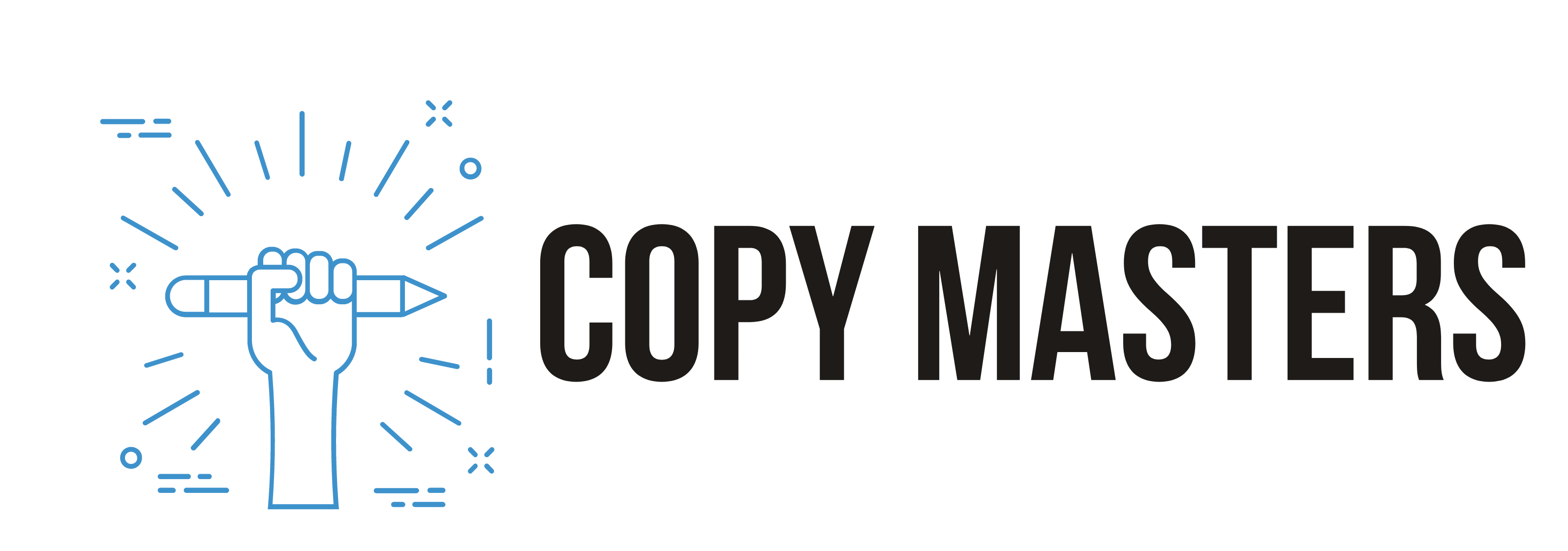If you want to create truly engaging content, you need a major mindset shift. Stop chasing clicks and start solving your audience's deepest problems. This is about moving past generic, cookie-cutter advice and delivering insights that are practical, empathetic, and actionable—the kind that makes someone feel like you're speaking directly to them.
Going Beyond Clicks to Build Real Connections
Let's be real for a second. The hamster wheel of chasing viral trends is exhausting, and it rarely builds anything that lasts. Real engagement isn't about a momentary spike in traffic; it's about forging a genuine connection that turns a first-time reader into a long-term fan.
The only way to do that is to become borderline obsessed with understanding who you're talking to.
Forget basic demographics like age and location for a minute. That's surface-level stuff. To create content that actually matters, you need to dig into the psychology of what makes your audience tick. What are their real-world problems, their secret ambitions, their day-to-day frustrations?
- What problems are actually keeping them up at night?
- What's a goal they're desperately trying to reach but keep failing at?
- What are the common mistakes they don't even know they're making?
- What's a small win you could help them achieve today?
When you can answer these questions, you stop writing for a vague "target market" and start creating for a real person. This is how you craft content that feels less like a blog post and more like a conversation with a trusted friend.
The Four Pillars of Content Engagement
To consistently create great work, it helps to have a simple framework. These aren't rigid rules, but more like guiding principles to keep you focused on what really moves the needle. To help visualize this, I've broken down the core elements into four key pillars.
| Pillar | Core Principle | Actionable Tip |
|---|---|---|
| Audience Empathy | Go beyond demographics to understand your audience's true pain points, desires, and challenges. | Create detailed user personas based on real conversations, surveys, and customer feedback. |
| Actionable Value | Provide clear, practical solutions that your audience can implement immediately to solve a problem. | Instead of just saying what to do, show them how to do it with step-by-step instructions or examples. |
| Authentic Voice | Develop a unique tone and perspective that reflects your brand and resonates with your audience. | Write like you speak. Don't be afraid to show personality and share personal experiences. |
| Compelling Format | Use visuals, storytelling, and smart formatting to make your content easy and enjoyable to consume. | Break up long text with images, blockquotes, and bullet points. Use strong headlines to guide the reader. |
These pillars aren't just a checklist; they're the foundation of a strategy that puts the reader first, which is the only way to build a loyal and engaged audience.
This infographic does a great job of summarizing how these elements come together.

As you can see, everything flows from that relentless focus on the audience. When you know who you're talking to, writing great headlines becomes easier. Understanding what they find interesting helps you choose the right visuals. It's an integrated approach. If you want to dive deeper into this, learning how to create engaging social media content that converts is a great next step.
The secret to engagement is empathy. When your audience believes you genuinely understand their struggles and want to help them succeed, they won’t just consume your content—they’ll champion it.
Ultimately, your goal is to make your reader the hero of their own story. Your content is just the helpful guide. By consistently showing up with valuable advice, you build trust. For more specific tactics on this, check out our other guide on proven ways to engage readers and keep them hooked. In the end, that trust is the most valuable asset you have.
Creating Video That Actually Gets Watched
Let's be real, in a world drowning in content, video isn't just another thing to do—it's the main event. But just hitting "publish" doesn't mean anyone's watching. If you really want to create engaging content, you need a solid plan to stop the endless scroll and get people to watch past the first three seconds.
This is truer than ever thanks to short-form video. Platforms like TikTok and Instagram Reels have totally rewired how people consume content. They expect value, and they expect it fast, packed into an entertaining little package.

The numbers don't lie. We're talking about a potential audience of 5.42 billion social media users worldwide, and video is what they're watching. Short videos can pull in 2.5 times more engagement than longer ones. It's no wonder that 56% of videos made by businesses are now under two minutes long.
The First Three Seconds Are Everything
Your video's opening is make-or-break. If you don't grab their attention right away, they're gone. Forget the slow, branded intros or artsy pans. You need a hook that sparks curiosity or promises a clear benefit, immediately.
Think of it as the headline for your video. A killer hook could be:
- A provocative question: "Are you making this common mistake with your morning coffee?"
- A surprising statement: "This one simple tweak doubled our website traffic overnight."
- A visual shock: Start with the amazing "after" shot before you even show the "before."
That first moment is your entire pitch. It gives the viewer a reason to stick around. Without it, even the best content in the world is just shouting into the void.
A Simple Scripting Formula for Impact
You don't need a Hollywood budget to make videos that connect with people. What you do need is a plan. A simple script keeps you from rambling and helps you get straight to the point. If you need some practical pointers, digging into these tips for writing video scripts that captivate viewers can make a world of difference.
Here’s a simple formula I've seen work time and again for videos under two minutes:
- The Hook (3-5 seconds): Hit them with your best question, statement, or visual to stop them in their tracks.
- The Problem (15-20 seconds): Briefly touch on a pain point your audience knows all too well. It shows you get them.
- The Solution (30-45 seconds): This is the good stuff. Share your core tip or insight that solves the problem.
- The Call to Action (10-15 seconds): Tell them what to do next. Ask for a comment, a follow, or a click.
Key Takeaway: The goal isn't just to be seen; it's to be remembered. Structure your videos to give the viewer a quick win, making them feel like their time was well spent.
This framework makes sure every second counts, leading your viewer from curiosity straight to action. When you focus on a tight story and immediate value, your videos stop being just another post and start becoming a serious tool for engagement.
Partnering with Creators for Authentic Reach

Let's be honest: your audience is sharp. They can sniff out a forced, inauthentic ad from a mile away. That's exactly why working with creators has become such a game-changer for building real trust. It’s about so much more than just paying someone for a quick shoutout.
The goal is to find genuine voices who are already trusted by the very community you're trying to connect with. This means looking past raw follower counts and focusing on true alignment. I've seen micro-creators with smaller, super-engaged audiences drive far better results than a celebrity with millions of followers who couldn't care less. A true partnership is built on shared values.
This isn't just a fleeting trend—it's a massive shift in marketing. Investment in the creator economy shot up by a staggering 143% since 2021. In fact, 70% of brands are now saying creator collaborations give them their highest return on investment. Why? Because creators forge genuine connections that a traditional ad simply cannot.
Finding the Right Creative Partners
The secret to finding the perfect creator isn't really about searching; it's about listening. Where does your ideal audience already spend their time online? Who do they turn to for recommendations in your niche?
A good starting point is to monitor relevant hashtags and communities on platforms like Instagram, TikTok, or even LinkedIn. Keep an eye out for creators who are consistently putting out high-quality, engaging stuff that matches your brand's personality and mission.
Once you’ve got a shortlist, it's time to dig into the quality of their engagement, not just the numbers.
- Dive into the comments: Are people having actual conversations, or is it just a wall of fire emojis?
- Check out their audience: Do their followers actually look like your ideal customer?
- Look at past sponsorships: Do their sponsored posts feel natural and authentic, or do they stick out like a sore thumb?
A great partner is someone whose endorsement feels like a friend's recommendation, not a paid-for placement.
Crafting a Brief That Inspires Creativity
The absolute worst thing you can do is hand a creator a rigid script and expect magic. It kills their creativity and produces content that feels, well, robotic. A collaborative brief is always the way to go.
Instead of dictating every single word, give them a solid framework with room to breathe.
- Nail the Core Message: Be crystal clear about the one or two key things you want the audience to walk away with.
- Outline the Non-Negotiables: This is where you include any mandatory brand guidelines, specific hashtags, or legal disclaimers. No surprises later.
- Encourage Their Voice: Explicitly tell them you chose them for their unique style and you want them to present the message in a way that feels natural to them.
Expert Tip: Think of a creator brief as guardrails, not a cage. You picked them for a reason—their unique ability to connect with their audience. Trust them and give them the freedom to work their magic.
This whole process is a masterclass in creating engaging content that doesn't scream "ADVERTISEMENT!" You're tapping into the creator's deep understanding of their audience, which is priceless. By embracing these principles, you can learn the 6 persuasion principles to attract your target audience through voices they already know and trust.
Making Your Content Personally Relevant
Let's be honest, generic content gets ignored. In a world overflowing with information, the only way to cut through the noise is to make your audience feel like you're talking directly to them. This means getting personal.
It's about digging deeper than surface-level topics and creating content that genuinely connects with your reader's life. This is where your audience data becomes gold. You're not just using it for ad targeting; you're using it to understand their real problems so you can craft a message that speaks their language and solves their specific pain points.
The numbers back this up. A huge 87% of consumers say that content on personally relevant topics is a major factor in their engagement. On top of that, 79% admit that tailored content like this makes them want to learn more about a brand. You can discover more creator economy insights from Spiralytics.com if you want to dig into the data.
Using Storytelling to Create Connection
One of the best ways to build this kind of connection is through storytelling. People don't connect with a list of features; they connect with stories that reflect their own experiences. Instead of just listing what your product does, you need to show them who it helps them become.
Try creating stories where your customer is the hero. For instance, a small business owner drowning in paperwork and disorganized finances is a story people can relate to. It's far more compelling than just a bulleted list of accounting software features. You're letting them see a version of their own success through the stories you tell.
Key Insight: Don't just sell a product; sell a transformation. Frame your content around the "after" state your audience desires, and position your brand as the guide that helps them get there.
Visuals are a massive help here. A whopping 76% of consumers say that content with strong visuals helps them imagine how a product would actually fit into their lives. This is a fundamental piece of building a great content marketing strategy for your small business.
Balancing AI Efficiency with a Human Touch
AI can be a fantastic assistant. It's great for brainstorming ideas or getting a rough first draft on the page, saving you a ton of time. But if you lean on it too heavily, you risk stripping all the personality and soul out of your work.
What makes your content trustworthy is you—your unique experiences, your perspective, and your voice. AI can't fake the empathy that comes from having been in your audience's shoes and genuinely understanding their struggles.
Here’s a simple way to use AI without sounding like a robot:
- Use AI for Ideation: Ask it for a list of blog topics or common questions people in your niche have.
- Let it Build the Skeleton: Have it whip up a basic outline or a first draft to get you started.
- You Provide the Heart: This is the most important part. Go in and rewrite the draft in your own words. Add your own stories, specific examples you've seen, and real, human emotion.
Think of AI as a junior assistant, not the writer. The final piece has to sound like it came from a real person. That's how you build trust and create content that truly connects.
Ensuring Your Best Content Gets Discovered

Look, creating a masterpiece is only half the job. The other, arguably harder half, is making sure people actually see it. Even the most brilliant insights will fall completely flat if they’re buried on page ten of Google or just another blip in a noisy social media feed.
This is where smart on-page optimization becomes your secret weapon.
And no, I'm not talking about stuffing keywords into every sentence. Real on-page SEO is about placing your primary keyword where it counts most: your title, your URL, and somewhere within the first 100 words of your intro. This just sends a clear signal to search engines about what your content is about, right from the get-go.
From there, it’s all about creating an experience that keeps people reading. It’s a harsh truth, but most people only read about 20% of the text on any given page. Scannability is absolutely non-negotiable. Break up those dense paragraphs, use bold text for the important stuff, and guide your reader’s eye with clear, descriptive subheadings.
Writing for Clicks and Shares
Beyond getting Google to notice you, you have to win over the human on the other side of the screen. Think about your meta description—that little snippet of text under your title in the search results. It’s your one shot at a first impression. It needs to be a movie trailer for your content, sparking curiosity and promising a real benefit for clicking.
For example, a dry description like "This post is about social media" is a guaranteed snooze-fest. Instead, try something with a little more punch: "Learn the three emotional triggers that make people share content—and how to build them into your next post for maximum reach." See the difference?
That same psychology is at play on social media. People don’t share content; they share emotions and identity. They share things that make them look smart, funny, or in-the-know.
To get a share, you have to give your reader a reason to stop scrolling. Content that evokes strong emotions—like awe, amusement, or even anger—is far more likely to be shared than something that’s purely informational.
To make sure your best work truly gets seen, it pays to explore some effective content distribution strategies as well. A great piece of content deserves a great promotion plan to match.
Building Shareability into Your Content
Here’s a tip: making your content shareable isn't something you do after you hit publish. It has to be baked in from the very beginning. Before you even start writing, ask yourself one simple question: "Why would someone share this?"
If you're stuck, here are a few triggers to build into your work:
- Practical Utility: Does your content solve a common, nagging problem so well that people will want to bookmark it and send it to friends?
- Unique Data or Insights: Can you offer a surprising statistic or a contrarian viewpoint that makes people stop and think, "Huh, I never thought of it that way"?
- Emotional Resonance: Does your story tap into a shared experience or a common goal that makes your readers feel seen and understood?
When you start focusing on these elements, you move beyond just creating "engaging content." You start creating content that travels all on its own. You're giving your audience the tools to become your biggest advocates, carrying your message far beyond where you could take it alone.
Answering Your Top Questions About Engaging Content
Even after you've got your strategy down, a few questions always seem to pop up when you're in the trenches creating content. I get it. So, let's tackle some of the most common hurdles creators run into. Think of this as a quick-and-dirty guide to refining your approach and getting better results.
How Do I Actually Measure Content Engagement?
Likes and views are nice, but they're vanity metrics. They don't tell you the whole story. To get a real sense of engagement, you have to look at what people do with your content, not just that they saw it.
For something like a blog post, you should be digging into these numbers:
- Time on Page: Are people actually reading? Or are they bouncing after a few seconds? This tells you if your content is holding their attention.
- Scroll Depth: How far down the page are they getting? If most people only see the first 25%, your intro or headline might need some work.
- Conversion Rate: This is the big one. Are they doing what you want them to do? That could be signing up for your email list, clicking a link to a product, or filling out a contact form.
When it comes to social media, forget the likes. Pay attention to shares, saves, and comments that are more than just an emoji. These actions mean someone found your content so valuable they wanted to keep it for later or show it to their friends. That's true engagement.
What Are the Biggest Mistakes People Make?
Hands down, the single biggest mistake is making the content all about you. When your blog posts and social updates are just sales pitches in disguise, people tune out fast. Your content has to solve a problem or answer a question for your audience. Always put yourself in their shoes and ask, "What's in it for them?"
Another classic blunder is inconsistency. If you only post once in a blue moon, you'll never build up any steam or create a loyal audience. People need to know they can count on you for regular, valuable content.
And finally, don't just hit "publish" and walk away. So many people forget that promotion is half the battle. You have to have a plan to get your masterpiece in front of the right eyeballs.
How Can a Small Business Compete in Content Creation?
Here's the good news: you don't need a Hollywood budget. Your biggest advantages are your specific expertise and your ability to be authentic. Don't try to be a massive corporation; lean into being you. Focus on solving one specific problem for your perfect customer and go deep on it.
A genuine, helpful video shot on a smartphone will almost always outperform a slick, corporate-style video that feels impersonal and distant. Value and authenticity are your greatest assets.
You can use free tools like Canva for amazing graphics and just use the phone in your pocket for video. The real pro move? Repurpose everything. That in-depth blog post you wrote can become 10 social media tips, a script for a short video, and the main feature in your next newsletter. Squeeze every last drop of value out of the work you do.
Ready to stop worrying about content and start seeing results? Copy Masters offers a subscription-based service that delivers 30 search-optimized articles every month, turning your blog into a powerful growth engine. Learn how we can help you outrank the competition today.
- SaaS SEO Consulting for Predictable Growth - October 20, 2025
- What Is SEO Management Your Guide to Real Results - October 19, 2025
- A Guide to Quality Content for SEO That Ranks - October 18, 2025
